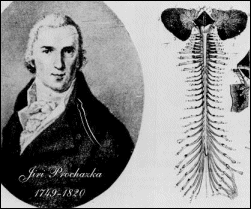What is voluntary and what is reflexive?
We use these words in our publications in our daily lives. The assumption is that we all know, more or less, what they mean. But when four colleagues, Francois Clarac (France), Gerald Loeb (USA), John Rothwell (UK), Jon Wolpaw (USA) and I tried to pin down their meaning, we came to rather different conclusions, as have many generations of scientists and philosophers before us (e.g. Jiri Prochazka (no relation), who coined the word "reflex" in the 18th century)

In broad terms, we either equated voluntary behaviors with consciousness and suppressibility or we viewed all behaviors as sensorimotor interactions, the complexity of which determines whether they are reflexive or voluntary. According to the first view, most movements of daily life are neither purely reflex nor purely voluntary. They fall into the middle ground of automatic motor programs. According to the second view as neuroscience advances the class of reflex behaviors will grow and the class of voluntary behaviors will shrink. For the full debate, download the pdf: WHAT DO REFLEX AND VOLUNTARY MEAN? MODERN VIEWS ON AN ANCIENT DEBATE.
Some historical facts about electricity used for therapy

Electrical Stimulation is no new invention, since the early 1900's it has been marketed as a miracle cure for most diseases dysfunctions and inadequacies as seen in this model of the Heidelberg Alternating Current Electric Belt. This model also came with a scrotal stimulator (not shown).
Sensory receptors in muscles and skin: What do they signal during movement?
Over the years, my lab has recorded the activity of the three main types of proprioceptors during normal movement (spindle primary and secondary afferents and tendon organ afferents). By combining all of the data obtained in locomotion into cycle averages, we've been able to test and fine-tune some of the mathematical models developed by other labs. The best-fitting models may now easily be used to run simulations by anyone who has access to Matlab Simulink. The simulations show the firing profiles of the afferents computed from muscle length or force variations.
Download a pdf of the book chapter "Quantifying Proprioception"
download a pdf of the simulink model in Fig 5 of "Quantifying Proprioception"
Download the actual model (you'll need Matlab 6.1 and Simulink to run it). Click on each of the following files
and save them all into Matlab's working directory, then run the simulink program qpfig5e.mdl
qpfig5e.mdl
TSIB1LEN.MAT
TSIB1EMG.MAT
TSIB1FRQ.MAT
HII1LEN.MAT
HIIEMG.MAT
HIIFRQ.MAT
TSIA5LEN.MAT
TSIA5EMG.MAT
TSIA5FRQ.MAT
DOES THE MOTOR SYSTEM USE POSITIVE FORCE FEEDBACK?
Q: Why doesn't positive force feedback with an open-loop gain >+1 cause muscle force to grow uncontrollably?
A: Because as the muscles shorten, the force they generate for a given change in motoneuron input declines: open loop gain automatically reduces to +1, which is stable.
The following studies address this and other reflex issues:
PROCHAZKA etal.(1997) J. Neurophysiol., 77: 3226-3236, PROCHAZKA et al.(1997) J. Neurophysiol., 77: 3237-3251.
Please Click here to download the simulink model in Figure 7 of this paper (you'll need Matlab 6.1 and Simulink)
Related Files:
PROCHAZKA, A. (2002) The man-machine analogy in robotics and neurophysiology. Journal of Automatic Control, Vol 10, Special Issue, ed. Popovic, D.
PROCHAZKA, A. (2000) WHAT DO REFLEX AND VOLUNTARY MEAN? MODERN VIEWS ON AN ANCIENT DEBATE
PROCHAZKA, A. (1999) Quantifying Proprioception
Other Simulink Models (click on Matlab icon):
PROCHAZKA et al. 1997, Fig. 7 Positive force feedback model (you'll need Matlab 6 and Simulink)
PROCHAZKA et al. 1997, Fig. 8 Positive force feedback model: force loop gain as a function of muscle length (you'll need Matlab 6 and Simulink)